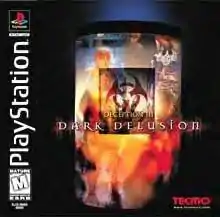Deception III: Dark Delusion
Deception III: Dark Delusion (Japanese: 蒼魔灯, Hepburn: Sōmatō) is a video game developed and published by Tecmo for PlayStation in 1999.
| Deception III: Dark Delusion | |
|---|---|
 North American cover art | |
| Developer(s) | Tecmo |
| Publisher(s) | Tecmo |
| Director(s) | Makoto Shibata |
| Composer(s) | Shun Otake Masaaki Udagawa Saki Ishii Ayako Toyoda Hiroshi Miyazaki Susumu Fujii Takayasu Sodeoka |
| Series | Deception |
| Platform(s) | PlayStation, PlayStation Network |
| Release | |
| Genre(s) | Strategy-RPG |
| Mode(s) | Single player |
Gameplay
Deception III expanded on the gameplay of Kagero by introducing a training mode, a mission mode, and trap enhancement through a series of crests and other artifacts. In the main story mode, players control Reina, a girl who, with her adoptive family, has been kidnapped and brought to the land of Burgenhagen to be sold into slavery. Reina must use the trapping powers she acquired to defeat her kidnappers and solve the mysteries of the pendant she wears, which other people seem to covet for unknown reasons.
The Free Training mode is simply a means of testing all of the available traps in a controlled environment with an immortal invader who can be programmed to adopt behavioral patterns, to learn their effects and uses without any real consequences. The mission mode, known as Expert Mode, assigns the player a given goal to achieve, usually within a time limit, with the traps available being any unlocked up to that point. Typical missions include "Crush the invader with a 4-hit combo" and "Make the killing hit a Pendulum trap". Also included is a Trap License mode which functions as a further tutorial, asking the player to perform various tasks that teach the nuances of the game in the name of learning helpful tips or trap functions. Traps are even more customizable than in previous games through the uses of Base Circles, Orbs, Emblems, and Rings. Base Circles contain the variety of trap involved (Pendulum, Arrow Slit, Bear Claw, etc.); Orbs determine the power level of the trap, ranging from 1 to 4; Emblems give the trap an element or special characteristic (Lightning, Fire, Slave, etc.); and Rings further enhance a trap by increasing their power, shortening their charge time, or a myriad number of other changes. The more modifications a trap employs, the more "Dreak" (the replacement for Kagero's Ark) it takes, but again, traps could be used infinitely upon creation. The loons from Kagero also returned as the sole means of regaining lost hit points. While not having secret traps, special emblems and rings can be acquired by achieving the game's four endings. Game saves are one block in size.
Reception
| Aggregator | Score |
|---|---|
| GameRankings | 71%[1] |
| Publication | Score |
|---|---|
| AllGame | |
| CNET Gamecenter | 7/10[3] |
| Electronic Gaming Monthly | 7.5/10[4] |
| EP Daily | 7.5/10[5] |
| Famitsu | 31/40[6] |
| Game Informer | 6.25/10[7] |
| GameFan | (G.N.) 97%[8] 83%[9][lower-alpha 1] |
| GamePro | |
| GameRevolution | B[11] |
| GameSpot | 6/10[12] |
| IGN | 6/10[13] |
| Next Generation | |
| Official U.S. PlayStation Magazine |
The game received above-average reviews according to the review aggregation website GameRankings.[1] Eric Bratcher of NextGen called it "a creative niche title, worth checking out if you have a strong stomach and want something new."[14] In Japan, Famitsu gave it a score of 31 out of 40.[6]
Notes
References
- "Deception III: Dark Delusion for PlayStation". GameRankings. CBS Interactive. Archived from the original on May 1, 2019. Retrieved June 26, 2021.
- Briggs, Rich. "Deception III: Dark Delusion - Review". AllGame. All Media Network. Archived from the original on November 15, 2014. Retrieved June 26, 2021.
- Steinberg, Scott (April 7, 2000). "Deception III: Dark Delusion". Gamecenter. CNET. Archived from the original on August 16, 2000. Retrieved June 26, 2021.
- EGM staff (April 2000). "Deception III: Dark Delusion". Electronic Gaming Monthly. No. 129. Ziff Davis.
- Nash, Jeff (June 12, 2000). "Deception III: Dark Delusion". The Electric Playground. Greedy Productions. Archived from the original on July 22, 2002. Retrieved June 26, 2021.
- "プレイステーション - 蒼魔灯". Famitsu (in Japanese). Vol. 915. Enterbrain. June 30, 2006. p. 22.
- Helgeson, Matt (April 2000). "Deception III: Dark Delusion". Game Informer. No. 84. FuncoLand. Archived from the original on December 6, 2000. Retrieved June 26, 2021.
- Ngo, George "Eggo" (April 2000). "Deception III: Dark Delusion". GameFan. Vol. 8, no. 4. Shinno Media. pp. 30–31. Retrieved June 26, 2021.
- Mylonas, Eric "ECM"; Weitzner, Jason "Fury"; Rodriguez, Tyrone "Cerberus" (April 2000). "Deception 3 [sic]". GameFan. Vol. 8, no. 4. Shinno Media. p. 12. Retrieved June 26, 2021.
- The D-Pad Destroyer (April 24, 2000). "Deception III: Dark Delusion Review for PlayStation on GamePro.com". GamePro. IDG Entertainment. Archived from the original on November 10, 2004. Retrieved June 26, 2021.
- Liu, Johnny (March 2000). "Dark Delusion: Deception III [sic] Review". GameRevolution. CraveOnline. Archived from the original on October 1, 2015. Retrieved June 26, 2021.
- Fielder, Joe (February 29, 2000). "Deception III: Dark Delusion Review". GameSpot. CBS Interactive. Retrieved June 26, 2021.
- Zdyrko, Dave (March 3, 2000). "Deception III: Dark Delusion". IGN. Ziff Davis. Retrieved June 26, 2021.
- Bratcher, Eric (April 2000). "Deception 3: Dark Delusion [sic]". NextGen. No. 64. Imagine Media. p. 89. Retrieved June 26, 2021.
- "Deception III: Dark Delusion". Official U.S. PlayStation Magazine. Vol. 3, no. 7. Ziff Davis. April 2000.